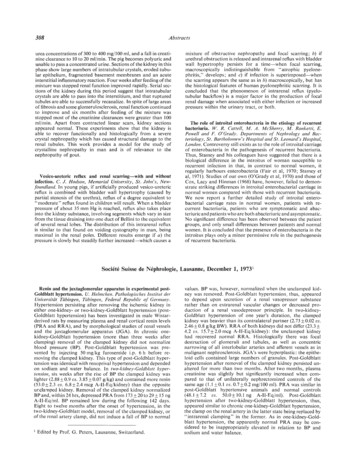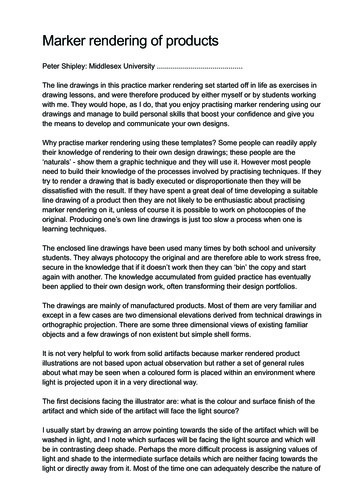
Transcription
Abstracts308urea concentrations of 300 to 400 mg/I 00 ml, and a fall in creatinine clearance to 10 to 20 mI/mm. The pig becomes polyuric andunable to pass a concentrated urine. Sections of the kidney in thisphase show large numbers of intratubular crystals, eroded tubu-mixture of obstructive nephropathy and focal scarring; h) iflar epithelium, fragmented basement membranes and an acuteinterstitial inflammatory reaction. Four weeks after feeding of themixture was stopped renal function improved rapidly. Serial sec-phritis," develops; and c) if infection is superimposed—whenthe scarring appears the same as in b) macroscopically, but hasthe histological features of human pyelonephritic scarring. It istions of the kidney during this period suggest that intratubularcrystals are able to pass into the interstitium, and that rupturedconcluded that the phenomenon of intrarenal reflux (pyelotubular backflow) is a major factor in the production of focaltubules are able to successfully recanalize. In spite of large areasof fibrosis and some glomerulosclerosis, renal function continuedrenal damage when associated with either infection or increasedpressure within the urinary tract, or both.urethral obstruction is released and intrarenal reflux with bladderwall hypertrophy persists for a time—when focal scarring,macroscopically indistinguishable from "atrophic pyelone-to improve and six months after feeding of the mixture wasstopped most of the creatinine clearances were greater than 100The role of introital enterobacteria in the etiology of recurrentmI/mm. Apart from contracted linear scars, kidney sectionsappeared normal. These experiments show that the kidney isable to recover functionally and histologically from a severecrystal nephropathy which has caused structural damage to therenal tubules. This work provides a model for the study ofPowell and F. O'Grady. Departments of Nephrology and Bac-nephropathy of gout.of enterobacteria in the pathogenesis of recurrent bacteriuria.Thus, Stamey and his colleagues have suggested that there is abiological difference in the introitus of woman susceptible tocrystalline nephropathy in man and is of relevance to thebacteriuria. W. R. (attell, M. .4. McSherry, M. Ronketti, E.teriology, St. Bartholomew's Hospital and St. Leonard's Hospital,London. Controversy still exists as to the role of introital carriagerecurrent infection in that, in contrast to normal women, itVesico-ureteric reflux and renal scarring—with and withoutinfection. C. J. Hodson, Memorial University, St. John's, Newfound/and. In young pigs, if artificially produced vesico-uretericreflux is combined with bladder wall hypertrophy (caused bypartial stenosis of the urethra), reflux of a degree equivalent to"moderate" reflux found in children will result. When a bladderpressure of about 35 mm Hg is reached, reflux also takes placeinto the kidney substance, involving segments which vary in sizefrom the tissue draining into one duct of Bellini to the equivalentof several renal lobes. The distribution of this intrarenal refluxis similar to that found on voiding cystography in man, beingmaximal in the renal poles. Different results emerge if a) thepressure is slowly but steadily further increased—which causes aregularly harbours enterobacteria (Fair et al, 1970; Stamey etal, 1971). Studies of our own (O'Grady et al, 1970) and those ofCox, Lacy and Hinman (1968) have, however, failed to demonstrate striking differences in introital enterobacterial carriage innormal women compared with those with recurrent bacteriuria.We now report a further detailed study of introital enterobacterial carriage rates in normal women, patients with recurrent bacteriuria, patients who are symptomatic and abacteriuric and patients who are both abacteriuric and asymptomatic.No significant difference has been observed between the patientgroups, and only small differences between patients and normalwomen. It is concluded that the presence of enterobacteria in theintroitus plays only a minor permissive role in the pathogenesisof recurrent bacteriuria.Société Suisse de Néphrologie, Lausanne, December 1, 1973'Renin and the juxtaglomerular apparatus in experimental postGoldblatt hypertension. U. J-felmchen. Pathologisches Inst if uf derUniversität Tdbingen, Tilbingen, Federal Republic of Germany.Hypertension persisting after removing the ischemic kidney ineither one-kidney- or two-kidney-Goldblatt hypertension (postGoldblatt hypertension) has been investigated in male Wistarderived rats by measuring plasma and renal cortical renin levels(PRA and RRA), and by morphological studies of renal vesselsand the juxtaglomerular apparatus (JGA). In chronic onekidney-Goldblatt hypertension (more than three weeks afterclamping) removal of the clamped kidney did not normalizeblood pressure (BP). Post-Goldblatt hypertension was prevented by injecting 50 mg/kg furosemide i.p. 6 h before removing the clamped kidney. This type of post-Gold blatt hypertension was identical with renopriva] hypertension and dependedon sodium and water balance. In two-kidney-Goldblatt hypertension, six weeks after the rise of BP the clamped kidney waslighter (2.88 0.9 vs. 3.85 0.07 g/kg) and contained more renin(53.0 2.3 vs. 6.8 2.4 meg A-lI-Eq/kidney) than the oppositeunclamped kidney. Removal of the clamped kidney normalizedBP and, within 24 hrs, depressed PRA from 173 20 to 29 15 ngA-li-Eq/nil. BP remained low during the following 142 days.Eight to twelve months after the onset of hypertension, in thetwo-kidney-Goldblatt model, removal of the clamped kidney, orof the renal artery clamp, did not induce a fall of BP to normal1Edited by Prof. G. Peters, Lausanne, Switzerland.values. BP was, however, normalized when the unclamped kidney was removed. Post-Goldblatt hypertension thus, appearedto depend upon secretion of a renal vasopressor substancerather than on extrarenal vascular changes or decreased production of a renal vasodepressor principle. In two-kidneyGoldblatt hypertension of one year's duration, the clampedkidney was heavier than its contralateral partner (2.73 0.02 vs.2.46 0.8 g/kg BW). RRA of both kidneys did not differ (23.34.2 vs. 15.7 2.0 meg A-li-Eq/kidney): the unclamped kidneyhad recovered normal RRA. Histologically there was focaldestruction of glomeruli and tubules, as well as concentricnarrowing of all interlobular arteries and afferent vessels as inmalignant nephrosclerosis. JGA's were hyperplastic: the epithebid cells contained large numbers of granules. Post-Goldblatthypertension after removal of the clamped kidney persisted unaltered for more than two months. After two months, plasmacreatinine was slightly but significantly increased when com-pared to that of unilaterally nephrectoniized controls of thesame age (1.10.1 vs. 0.7 0.2 mg/100 ml). PRA was similar inpost-Goldblatt hypertensive animals and normal controls(48.1 7.2 vs. 50.0 10.1 ng A-Ii-Eq/ml). Post-Goldblatthypertension after two-kidney-Goldblatt hypertension, thus,appeared similar to chronic one-kidney-Goldblatt hypertension,the clamp on the renal artery in the latter state being replaced by"intrarenal clamping" in the former. As in one-kidney-Goldblatt hypertension, the apparently normal PRA may be considered to be inappropriately elevated in relation to BP andsodium and water balance.
AbstractsDepression of the natriuretic effect and the urinary excretion of309furosemide by probenecid. Y. Arsian and J. Diezi. Inst itut dePharmacologic de I' Université, Lausanne, Switzerland. Thenatriuresis induced by furosemide (F) has been shown to beplantation with bilateral nephrectomy. Morphological examination of the kidneys confirmed the presence of chronic pyelonephritis; in addition, we noted numerous birefringent crystals inthe tubular epithelium and in giant-cell interstitial granulomas.antagonized by previous administration of probenecid (P).The type of antagonism and a possible correlation betweenThe crystals were investigated by means of electron-probex-ray microanalysis and were found to contain sulfur. Sinceinhibition of F natriuresis by P and depression of urinary excre-Dolo-Euvernil was the only sulfur-containing drug given to thetion of F itself after P administration were investigated. Un-patient, it may be assumed that the crystals contained sulfacarbamide or a metabolite. The presence of such crystals inanesthetized female Wistar-type rats were continuously infusedwith saline containing inulin (0.2 mi/mm) and, for 100 mm, Pat 1 mg/kg.min. After 100 mm, 0.3 to 160 smoles/kg of F wereinjected i.v. Controls were treated similarly, but did not receiveP. GFR, urinary excretion of Na, K and F were measured.Log dose-effect relationships indicated that P acted as a competitive antagonist of the natriuretic and kaliuretic effects of F:after P. the sigmoid log dose-effect curves were parallelly displaced to the right without alteration of the maximal effect of F.The natriuretic potency of F was decreased, after P administration, by a factor of 10. In parallel, P inhibited the urinary excretion of F: 50 of single i.v. doses of F was excreted within 15interstitial granulomas suggested that the sulfonamide may haveaggravated the preexisting renal disease and perhaps contributed to its irreversibility. The presence of intratubular sulfonamide crystals and the subsequent development of interstitial nephritis were described in the first era of the clinical useof sulfonamides. 1 he present observation shows that thiscomplication may also occur with the sulfonamides used at thepresent time in spite of their lower nephrotoxicity.mm in the urine of controls, 11% in P-treated animals. TheSNGFR and renal cortical plasma flow during compensatoryadaptation in rats. J. Diezi and Pierrette Michoud. Institut c/cinhibition of the natriuretic effect of F was directly proportionalPharmacologic de 1' Université de Lausanne, Lausanne, Switzer-to the decrease of its urinary excretion. These obversationsdemonstrate that tubular secretion of F is a condition for itsnatriuretic effect, which may depend on the presence of F inland. Removal of one mammalian kidney is followed by antubular fluid.Evidence for renal tubular secretion of inorganic phosphate inthe rat. J.-F. Boudr.v, U. Troehier, M. Tooabi, H. Fleisch andJ.-P. Bonjour. Pathophysiologisches Institut der Universität Bern,Bern, Switzerland. The possible occurrence of tubular secretionof inorganic phosphate (P1) in the mammalian kidney has beeninvestigated in rats infused with sodium phosphate (3 to 10moles/min). Clearance studies and free-flow micropuncture andmicroperfusion of proximal tubules in situ were performed. Inclearance studies in anesthetized rats, net tubular reabsorptionper ml GFR decreased markedly in response to P1 infusion. Asimilar decrease occurred in thyroparathyroidectomized rats,albeit at a higher plasma concentration of P1. In conscious ratsthe clearance of P, sometimes exceeded GFR at high plasma P1concentration. Free-flow micropuncture in control rats showednet tubular reabsorption of P1 along the proximal, and probablybetween the end of the distal tubule and the ureteral urine. Inphosphate-loaded rats, receiving parathyroid hormone (PTH,0.042 lU/mm i.v.) or untreated, an apparent net secretion of P1was observed between the end of the distal tubule and the ureteral urine. En the phosphate-loaded group receiving PTH, netsecretion was also observed in the first part of the proximaltubule, followed by predominant reabsorption along this segment. Thus, the early proximal tubule, and probably also theterminal nephron, may be the site of either net reabsorption ornet secretion. Microperfusion of proximal tubules showed a fallof the specific activity of perfused radioactive P1, indicating anentry of P1 into the lumen. In conclusion, evidence indicatingtubular secretion of phosphate has been obtained by threedifferent techniques in phosphate-loaded rats.almost immediate increase in urine flow from the contralateralkidney (compensatory adaptation: CA). Male Sprague-Dawleyrats were infused at 3 mI/hour with isotonic saline containinginulin and PAH. Inulin TF/P and SNGFR were measured inproximal tubules before (period 1) and after (period 2) removalof the contralateral kidney (11 rats). No recollections were made.Single nephron PAH clearance (SNEPF) was measured in distaltubules in order to evaluate cortical plasma flow. Sham-operatedrats (N 9) were used as controls. End-proximal TF/P decreased significantly from 2.4 to 1.9 between the two periods inexperimental rats, indicating decreased fractional reabsorption,but did not change in controls. SNGFR did not change in eithergroup. SNEPF averaged 88.8 3.9 nI/mm in controls and 81.43.9 ni/mm in experimental rats (NS). Cortical filtration fraction(SNGFR/SNEPF distal SNFF) did not differ between the twogroups nor did it differ from the whole kidney FF (CIfl/CpAn)within each group. It was concluded that the major change insuperficial nephrons during CA is a decrease in fractional andabsolute fluid reabsorption from proximal tubules withoutchange in SNGFR or SNEPF. Increases in SNGFR previouslyreported to occur in these conditions are considered to be anartefact related to the recollection technique. Identity of SNFFand whole kidney FF indicates PAR extraction 100% fromblood flowing through cortical nephrons.Hematomyelia after hemodialysis. C. Descoeudres, V. D'Apuzzoand 0. Oetliker. Medizinische Poliklinik and Kinderklinik,Unirersität Bern, Bern, Switzerland. A 13-year-old boy withsubactute proliferative glomerulonephritis first underwenthemodialysis in August 1973. Immediately before dialysis,BUN and serum creatinine, thrombocyte count and Quick valuewere 87 mg/100 ml, 15.3 mg/100 ml, 103,000/mm3 and 72%,respectively. A Mini-D-Kiil apparatus (Cobe Co.) was used forseven hours without complication. During this time the patientreceived a continuous infusion of 11,500 units of heparin(Liquemin) and at the end of the dialysis an i.v. inject
carbamide or a metabolite. The presence of such crystals in interstitial granulomas suggested that the sulfonamide may have aggravated the preexisting renal disease and perhaps contri-buted to its irreversibility. The presence of intratubular sul-fonamide crystals











